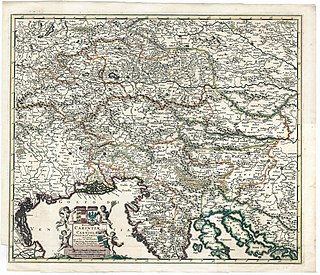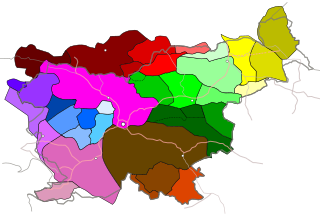Historical
List of historical newspapers include also the newspapers that were published German:
- 1787–1918 Laibacher Zeitung , main German-language newspaper of Ljubljana
In 2004, there were nearly 1,000 printed media in Slovenia, including newspapers, magazines and journals. [1]
This article is a list of newspapers published in Slovenia or in Slovene.
| Title | English Title | Content | Format | Est. | Owner | Publisher | Headquarters | Orientation | Website |
|---|---|---|---|---|---|---|---|---|---|
| Delo | Labor | General | Broadsheet | 1959 | FMR, d.d. | Delo, d.d. | Ljubljana | Left-wing, Social liberalism | delo |
| Dnevnik | Journal | General | Berliner | 1951 | 35%: Državna založba Slovenije (State Publishing House of Slovenia) 25,74%: Styria Media International AG and others | Dnevnik, d.d. | Ljubljana | Left-wing | dnevnik |
| EkipaSN | TeamSN | Daily sports news | / | 1995 | Media24 | Salomon, d.o.o. | Ljubljana | / | ekipa24 |
| Finance | Finances | Daily business and financial news | Berliner | 1992 | Bonnier Group | Časnik Finance, d.o.o. | Ljubljana | Liberalism, Centrism | finance |
| Slovenske novice | Slovenian News | General | Tabloid | 1991 | Delo, d.d. | Delo, časopisno založniško podjetje d.o.o. (Delo Publishing) | Ljubljana | ? | slovenskenovice |
| Večer | Evening | General | Berliner | 1945 | Dober večer | Časnik Večer, d.o.o. | Maribor | Centrism | vecer |
| Svet24 | World24 | General | Tabloid | 2013 | Media24 | Salomon, d.o.o. | Ljubljana | ? | svet24 |
List of historical newspapers include also the newspapers that were published German:

The history of Slovenia chronicles the period of the Slovenian territory from the 5th century BC to the present. In the Early Bronze Age, Proto-Illyrian tribes settled an area stretching from present-day Albania to the city of Trieste. The Slovenian territory was part of the Roman Empire, and it was devastated by the Migration Period's incursions during late Antiquity and the Early Middle Ages. The main route from the Pannonian plain to Italy ran through present-day Slovenia. Alpine Slavs, ancestors of modern-day Slovenians, settled the area in the late 6th Century AD. The Holy Roman Empire controlled the land for nearly 1,000 years, and between the mid-14th century and 1918 most of Slovenia was under Habsburg rule. In 1918, most Slovene territory became part of the Kingdom of Serbs, Croats, and Slovenes, and in 1929 the Drava Banovina was created within the Kingdom of Yugoslavia with its capital in Ljubljana, corresponding to Slovenian-majority territories within the state. The Socialist Republic of Slovenia was created in 1945 as part of federal Yugoslavia. Slovenia gained its independence from Yugoslavia in June 1991, and today it is a member of the European Union and NATO.

The Slovenes, also known as Slovenians, are a South Slavic ethnic group native to Slovenia, and adjacent regions in Italy, Austria and Hungary. Slovenes share a common ancestry, culture, history and speak Slovene as their native language. They are closely related to other South Slavic ethnic groups, as well as more distantly to West Slavs.

Prekmurje is a geographically, linguistically, culturally and ethnically defined region of Slovenia, settled by Slovenes and a Hungarian minority, lying between the Mur River in Slovenia and the Rába Valley in the westernmost part of Hungary. It maintains certain specific linguistic, cultural and religious features that differentiate it from other Slovenian traditional regions. It covers an area of 938 square kilometers (362 sq mi) and has a population of 78,000 people.

Styria, also Slovenian Styria or Lower Styria, is a traditional region in northeastern Slovenia, comprising the southern third of the former Duchy of Styria. The population of Styria in its historical boundaries amounts to around 705,000 inhabitants, or 34.5% of the population of Slovenia. The largest city is Maribor.

Slovene Americans or Slovenian Americans are Americans of full or partial Slovene or Slovenian ancestry. Slovenes mostly immigrated to America during the Slovene mass emigration period from the 1880s to World War I.

United Slovenia is the name originally given to an unrealized political programme of the Slovene national movement, formulated during the Spring of Nations in 1848. The programme demanded (a) unification of all the Slovene-inhabited areas into one single kingdom under the rule of the Austrian Empire, (b) equal rights of Slovene in public, and (c) strongly opposed the planned integration of the Habsburg monarchy with the German Confederation. The programme failed to meet its main objectives, but it remained the common political program of all currents within the Slovene national movement until World War I.
Carinthian Slovenes or Carinthian Slovenians are the indigenous minority of Slovene ethnicity, living within borders of the Austrian state of Carinthia, neighboring Slovenia. Their status of the minority group is guaranteed in principle by the Constitution of Austria and under international law, and have seats in the National Ethnic Groups Advisory Council.
Hungarian Slovenes are an autochthonous ethnic and linguistic Slovene minority living in Hungary. The largest groups are the Rába Slovenes in the Rába Valley in Hungary between the town of Szentgotthárd and the borders with Slovenia and Austria. They speak the Prekmurje Slovene dialect. Outside the Rába Valley, Slovenes mainly live in the Szombathely region and in Budapest.
Miklós Küzmics was a Hungarian Slovene writer and translator.

Gregorij Rožman was a Slovenian Roman Catholic prelate. Between 1930 and 1959, he served as bishop of the Diocese of Ljubljana. He may be best-remembered for his controversial role during World War II. Rožman was an ardent anti-communist and opposed the Liberation Front of the Slovene People and the Partisan forces because they were led by the Communist party. He established relations with both the fascist and Nazi occupying powers, issued proclamations of support for the occupying authorities, and supported armed collaborationist forces organized by the fascist and Nazi occupiers. The Yugoslav Communist government convicted him in absentia in August 1946 of treason for collaborating with the Nazis against the Yugoslav resistance. In 2009, his conviction was annulled on procedural grounds.

Prekmurje Slovene, also known as the Prekmurje dialect, East Slovene, or Wendish, is a Slovene dialect belonging to a Pannonian dialect group of Slovene. It is used in private communication, liturgy, and publications by authors from Prekmurje. It is spoken in the Prekmurje region of Slovenia and by the Hungarian Slovenes in Vas County in western Hungary. It is closely related to other Slovene dialects in neighboring Slovene Styria, as well as to Kajkavian with which it retains a considerable degree of mutual intelligibility and forms a dialect continuum with other South Slavic languages.

The Republic of Prekmurje was an unrecognized state in Prekmurje, an area traditionally known in Hungarian as Vendvidék . On June 6, 1919, Prekmurje was incorporated into the newly established Kingdom of Serbs, Croats and Slovenes.
Argentines of Slovene descent, also Slovene Argentines or Argentine Slovenes are the Slovenes residing in Argentina. According to Jernej Zupančič of the Slovenian Academy of Sciences and Arts, they number around 30,000.

József Szakovics, Slovene Jožef Sakovič, German orthography Joseph Sakowitsch, was a Slovene Roman Catholic priest and author in the Prekmurje region. Szakovics was a defender of the linguistic rights of the Hungarian Slovenes and their Slovene identity, promoting the use of the Prekmurje dialect of Slovene.
The Slovene March or Slovene krajina was the traditional denomination of the Slovene-speaking areas of the Vas and Zala County in the Kingdom of Hungary from the late 18th century until the Treaty of Trianon in 1919. It comprised approximately two-thirds of modern Prekmurje, Slovenia, and the modern area between the current Slovenian-Hungarian border and the town of Szentgotthárd, where Hungarian Slovenes still live. In Hungarian, the latter area is still known as Vendvidék, which is the Hungarian denomination for the Slovene March, while in Slovene it is referred as Porabje.

Young Slovenes were a Slovene national liberal political movement in the 1860s and 1870s, inspired and named after the Young Czechs in Bohemia and Moravia. They were opposed to the national conservative Old Slovenes. They entered a crisis in the 1880s, and disappeared from Slovene politics by the 1890s. They are considered the precursors of Liberalism in Slovenia.

József Klekl was a Slovene Roman Catholic priest from Prekmurje and politician in Hungary, writer, governor of the Slovene People's Party (Slovenska lüdska stranka), later a delegate in Belgrade. Klekl was an active proponent of the independence of the Slovene March in Hungary (Slovenska krajina), and for some time fusion with the State of Slovenes, Croats and Serbs.

Ferenc Hüll was a Slovene Roman Catholic priest, dean of the Slovene March (Tótság), and a writer in Hungary.

István Kühár was a Slovene Roman Catholic priest, politician, and writer in Hungary, and later in Yugoslavia.